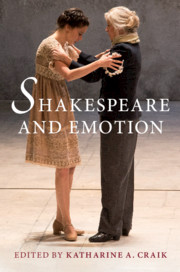Book contents
- Shakespeare and Emotion
- Shakespeare and Emotion
- Copyright page
- Contents
- Figures
- Contributors
- Acknowledgements
- Note on Text
- Introduction
- Part I Contexts
- Chapter 1 Rhetoric
- Chapter 2 Medicine
- Chapter 3 Religion
- Chapter 4 Character
- Chapter 5 Inheritance and Innovation
- Chapter 6 Communities
- Chapter 7 Audiences
- Chapter 8 Acting
- Chapter 9 Bollywood
- Chapter 10 Language
- Chapter 11 Emotional Labour
- Chapter 12 Passionate Shakespeare
- Part II Emotions
- Bibliography
- Index
Chapter 3 - Religion
Henry VI, Henry IV, Henry V
from Part I - Contexts
Published online by Cambridge University Press: 01 October 2020
- Shakespeare and Emotion
- Shakespeare and Emotion
- Copyright page
- Contents
- Figures
- Contributors
- Acknowledgements
- Note on Text
- Introduction
- Part I Contexts
- Chapter 1 Rhetoric
- Chapter 2 Medicine
- Chapter 3 Religion
- Chapter 4 Character
- Chapter 5 Inheritance and Innovation
- Chapter 6 Communities
- Chapter 7 Audiences
- Chapter 8 Acting
- Chapter 9 Bollywood
- Chapter 10 Language
- Chapter 11 Emotional Labour
- Chapter 12 Passionate Shakespeare
- Part II Emotions
- Bibliography
- Index
Summary
This chapter explores the theatre’s interest in the intersection of religion and emotion by focusing on two characters from Shakespeare’s history plays—Falstaff and Joan la Pucelle—who reference the real-life martyrs Jeanne d’Arc and John Oldcastle. Martyrdom was a cultural phenomenon with the potential for considerable dramatic impact on the stage, but the act of transforming it into theatrical representations had to be handled with exceptional care. Accordingly, the history plays walk a kind of tightrope, evoking Jeanne and Oldcastle through patterns of strategic indirection, including substituting minor characters for more controversial ones and killing characters off stage rather than on. Such techniques create crucial layers of distance that protect the audience from staring too closely at events already overloaded with meaning. Feelings of sympathy transmitted to the audience were thus carefully detached from real-life martyrs, interrupting and redirecting the cycle of religiously-charged emotional identification.
Keywords
- Type
- Chapter
- Information
- Shakespeare and Emotion , pp. 49 - 63Publisher: Cambridge University PressPrint publication year: 2020

